Battling for Hue
Tags
Back to Vietnam with a very early (1973) game entitled “Battle for Hue,” designed by John Hill of later Squad Leader fame.
Battle for Hue is not a “pretty” game, not at all. The map and counters are workaday servicable, there is no eye candy here. That said, the type on the 1/2” counters is large and easy to read, even in lower light.
More features of the game:
- Rules are one sheet of folded tabloid.
- There are no hex numbers on the map.
- CRT is bloody: there is no defense, simply firepower.
- The counters have firepower and range values, there is no defense factor on any counter. There is no dispersion, step loss or disorganization. A unit either survives an attack or it does not.
- Fire is “simultaneous.” Units being fired on can (usually) return fire. No units are removed until they can return fire.
- The game could run more than 36 turns, as the game ending condition is “no more NVA/VC in the inner city.” I may not play this game quite that long.
Lacking any idea of what I need to do, here’s my initial set up for a solo game:
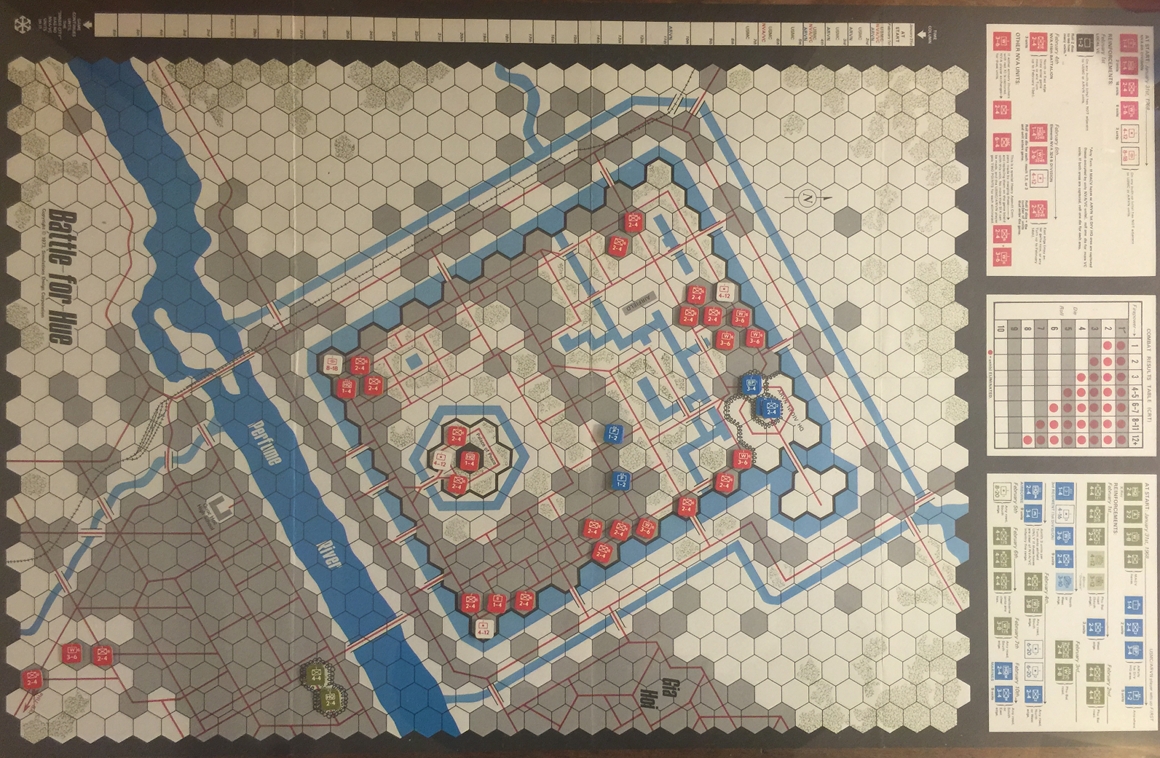
In the north, NVA focus is on capturing the armory as fast as possible to get counter upgrades, including extra VC rolls. In the south, NVA will attempt to roadblock and ZOC US entry from Phu Bai. Note that all the NVA in the inner city start in built up areas, and have no stacking capability.
Let’s see what happens.
January 31, 1968: opening moves
NVA Move NVA moves up to ARVN armory, ARVN “first fire” fails with a d6 roll 6. Rolling a 6 in this game is pretty much bad news at any odds, what with the DRMs.
First Fire Phase NVA targets the ARVN armory. The choice is whether to play it safe and wear down the bunkered and barbed wire defense (+4 DRM) over a couple of turns, or take the riskier option of trying to eliminate more units with lesser firepower per unit. Since the NVA can use rockets this turn, the safer alternative looks better: take out the higher firepower ARVN defenders first. First roll is a 3 at 111, defender eliminated. Second roll is a 2 at 11, also defender eliminated. Follow on attacks by W 3-6 units eliminate on a roll of 1: roll, 1, 3! Bunker next to ARVN armory is clear, 1 unit in armory remains.
ARVN fires: roll 3 defender in clear, eliminated, roll 6 miss.
ARVN/US Road Movement Police units move to flank NVA infantry unit.
ARVN/US Non-road Movement close with NVA, first fire: NVA rolls 5 on firepower 2, miss.
Second Fire Phase: ARVN rolls 5, miss, NVA rolls 2, miss with +2 DRM in city hex.
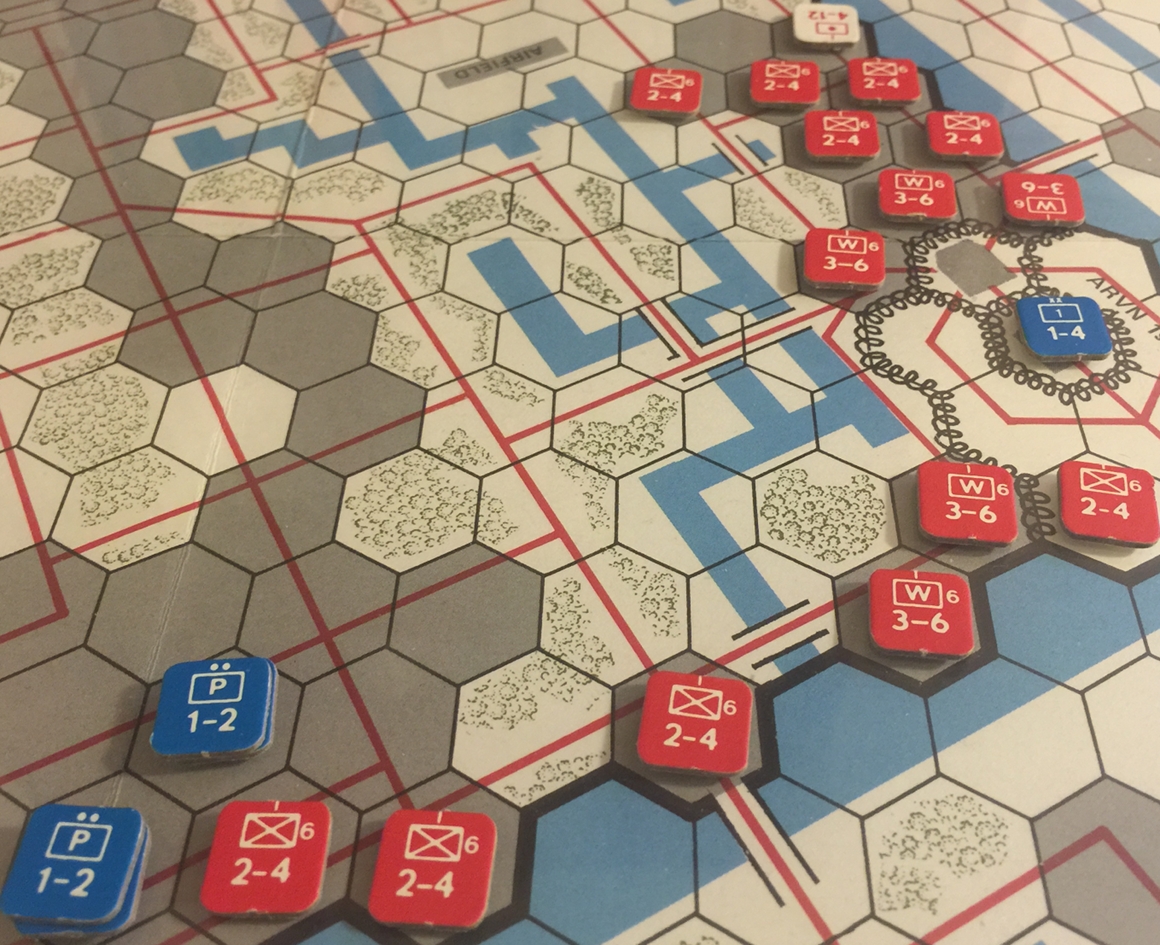
NVA get 1 VP for each of the 3 ARVN eliminated and 1 VP for one turn in inner city.
Score
- NVA 4.
- ARVN/US 1.
And that’s it for Turn 1, January 31, 1968.
February 1, 1968: VC eruption
The VC enter the game this turn, determined by rolling 2 d6: 9! What a great roll for the commies. The few reviews for this game emphasize the hopelessness of the NVA/VC situation, but it’s looking about as good as it could at the moment.
NVA Move small repositioning to get better odds on armory and police units.
First Fire Phase ARVN armory: roll 4, armory will belong to NVA next movement turn. 2 more ARVN police units elminated by artillery fire.
ARVN/US Road no movement.
(Note: I forgot to bring in ARVN/US reinforcements on this phase. This didn’t matter for the US forces as the Phu Bai road was blocked by NVA. It does make a difference for the ARVN forces as they come in on the west edge and will certainly attempt to eliminate the NVA artillery as soon as possible. The three ARVN units will come on February 2 with the usual reinforcements.)
ARVN/US Non-road engage NVA/VC in southeast inner city, first fire misses.
Second Fire Phase 1 VC and 1 Police unit eliminated.
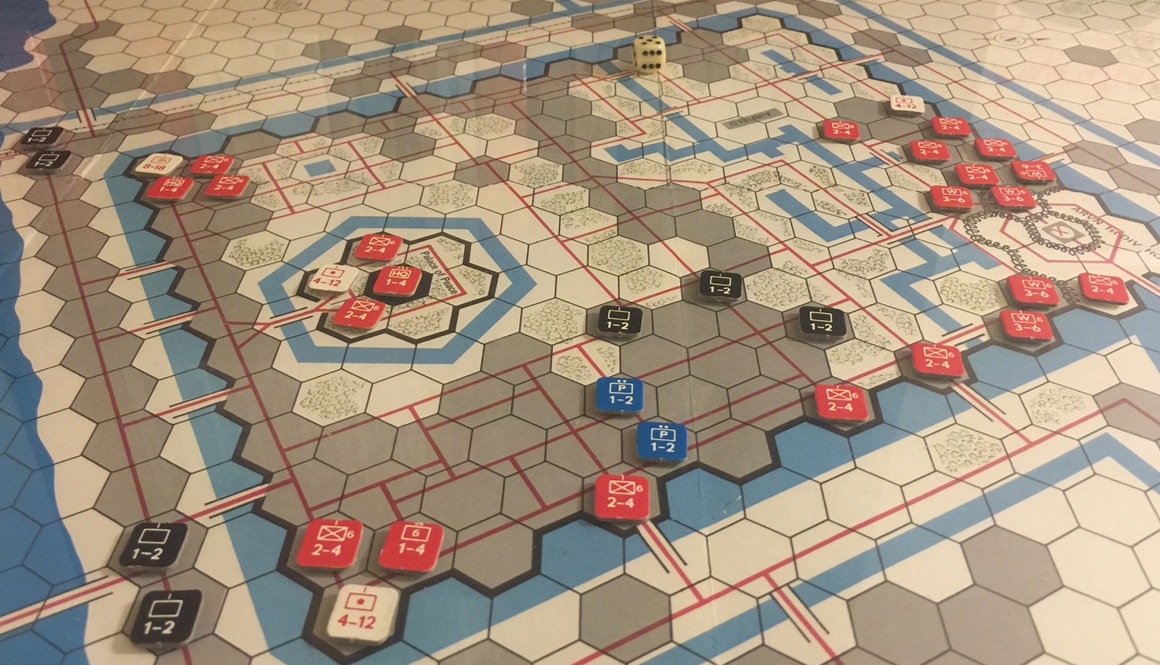
Score: NVA 2 turns + 8 ARVN = 10; ARVN/US 2 NVA.
February 2, 1968: ARVN to the rescue!
NVA/VC Move Time to blow at least some bridges, and hope not to get caught out.
First Fire Phase 2 more ARVN bite it. NVA artillery is very effective. Marines come out to play, firing on VC blocking far egress on eastern Perfume River bridge. FP 6, +2 DRM, roll 4, eliminate. Return fire ineffective.
ARVN/US Road move into position to eliminate NVA artillery.
ARVN/US Non-road positioning for massive fire onslaught against NVA artillery.
Second Fire Phase lots going on:
- ARVN eliminate an NVA artillery which was foolishly placed in a wall corner.
- ARVN Eliminated the rockets. Bad news for NVA.
- The NVA rockets took out a stack of ARVN armor/infantry which was in the clear. ARVN considers this a pretty good trade.
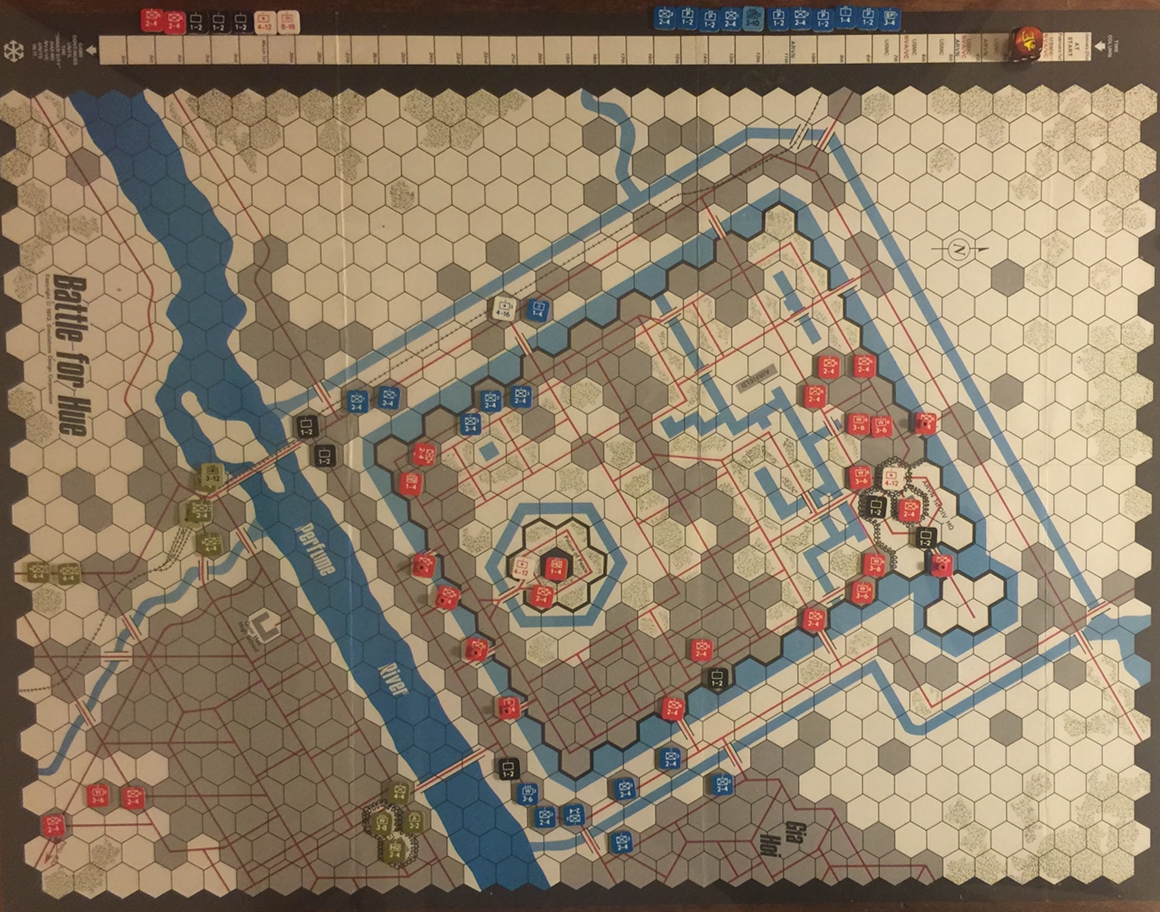
NVA kills in the upper right, ARVN/US kills in the upper left.
Score: NVA 14, ARVN 7.
ARVN is catching up.
February 3, 1968: NVA arms itself at ARVN expense
The NVA get to rob the ARVN armory captured a couple of days ago. Roll 2 d6 for 8, this is needed firepower what with the majority of the artillery eliminated. Also, roll 1 d6 or VC activation: 4. This is a pretty sweet upgrade for the communist forces.
NVA Move VC placed in inner city to deny key intersections to slow down ARVN movement.
First Fire Phase No firing units this phase.
ARVN/US Road move inner city ARVN positioning to take out VC road blocks one at a time. US slight repositioning to eliminate VC in southwest corner. Other ARVN positioning to clear bridges into inner city.
ARVN/US Non-road move Position to fight!
Second Fire Phase Lots of action all over the board. Overall, ARVN got a couple of unlucky rolls, VC got a lucky roll.
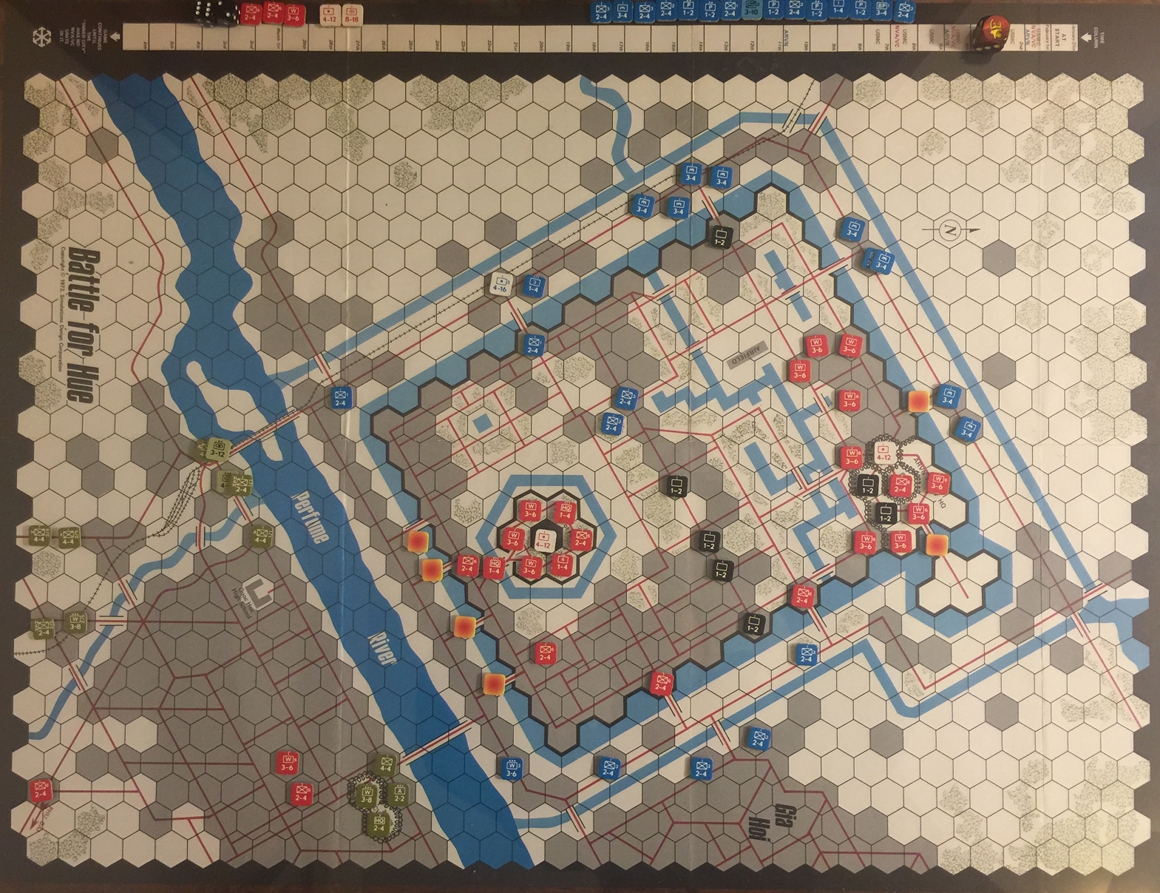
Score: NVA 15 kills + 4 turns = 19, ARVN/US 13 kills.
The NVA has a long, long way to go, and there are a lot of Marines in the way. Losing both artillery pieces was a huge bummer for the NVA.
February 4, 1968: ARVN brings the Big Guns
Only 1 VC unit rolls in.
NVA Move New VC unit replaces eliminated unit at bridge along north wall of inner city. ARVN will have to continue fighting, or just use the non-road movement to cross into the inner city.
First Fire Phase Tit for tat mostly. At this point, that’s bad for NVA.
ARVN/US Road move The ARVN rolls in to inner city to destroy VC roadblocks. The Marines flood the inner city using road movement now that there is a bridge open.
ARVN/US Non-road move Allies close to fight! VC unable to score on first fire.
Second Fire Phase Tit for tat on a VC/ARVN exchange, not a bad deal considering the VC outgunned here. Much more bloodiness ensues. NVA picks off one of the Marine armor units, and another Marine unit, but lost one of the HACs.
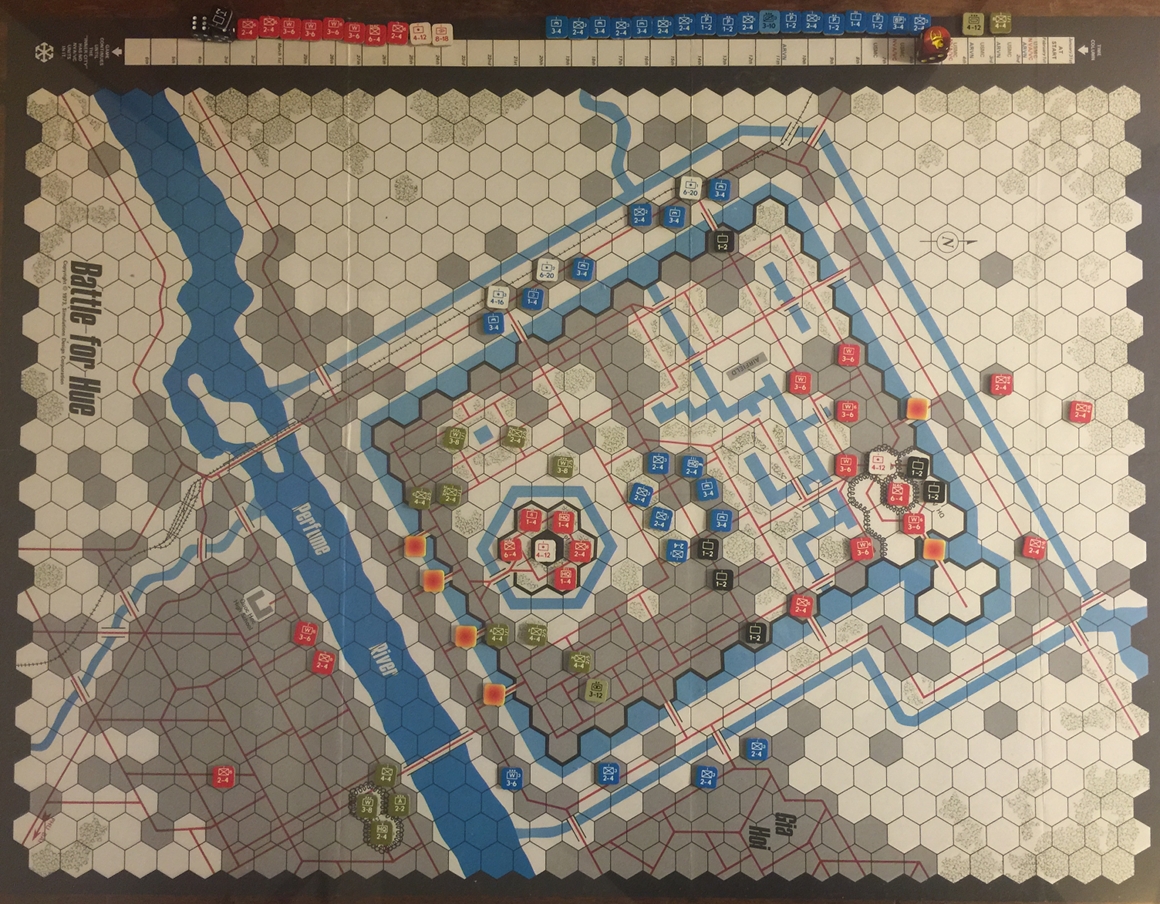
Score: NVA 27, ARVN/US 21.
It’s going to be hard for NVA to nullify the 20 point bonus Allies get for clearning NVA out of the inner city.
February 5, 1968: Marines bring out the cannons
3 VC rolled in.
NVA Move At this point, lacking the artillery, and having one of the HAC eliminated without being used, the NVA/VC are in a bind. Movement this phase is positioning for attrition combat.
First Fire Phase NVA did not use artillery effectively, probably cost it at least 1 Marine casualty.
US/ARVN Road move Marines moving away from Palace of Peace for now, toward ARVN 1st Div HQ, ARVN doing the same. Will attempt to “sweep up” NVA units before assaulting the HQ.
US/ARVN Non-road move Position for combat in urban terrain.
Second Fire Phase NVA Lucky shot, took out 4-4 Marine infantry! There was a 1/6 chance; the NVA are getting really lucky this game. The Marines are getting totally pwned.
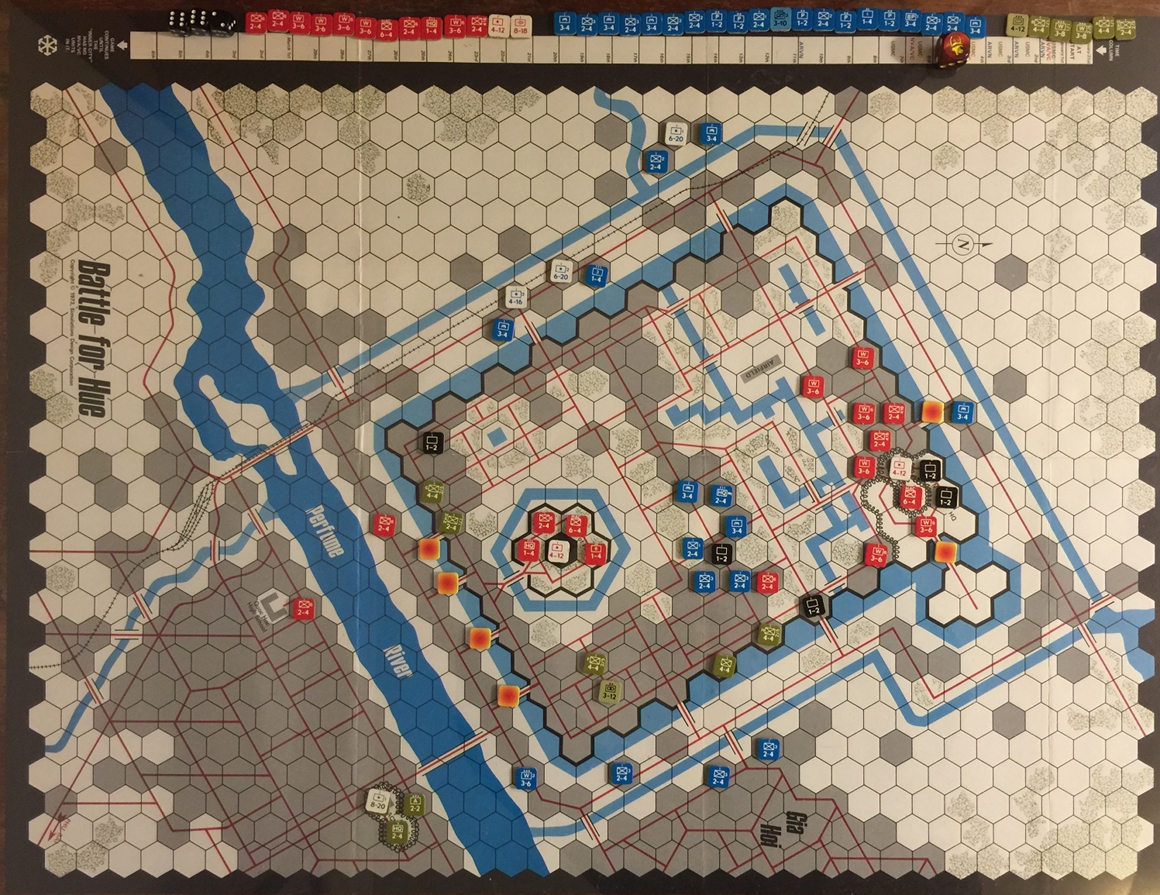
Score: NVA 6 + 20 + 12 = 38, ARVN/US 12 + 12 + 2 (HAC) = 26.
Those Marines add up fast for NVA scoring.
February 6, 1968
I need to start timing my plays. Once I know how long a turn takes, I can figure out how to squeeze in a turn or two at random intervals.
First, NVA reinforcements. Up to 3 units may enter on a die roll of 1,2 or 3. The first 2 rolls are 5, the second is “3,” so the NVA get an another piece of artillery. Also, roll 2 d6 to determine how much of the NVA 324B enters on February 6, super lucky roll, 11! Only 1 VC though.
NVA Move Bring in new reinforcements on the southeast side of the map, half to relieve the inner city, the other half to attempt to destroy artillery. One 324B 2-4 lost right away one an attempt on the USMC MACV armory. Not sure this is a good idea for NVA, but feels like it’s worth trying. Probably could have committed more than 2 units to the MACV, but risked losing all of them on ZOC-controlled first fire.
First Fire Phase Eliminated the USMC unit on the armory hex. Won’t be able to hold it, but it’s another 2 VP.
ARVN/US Road Move At this point, the ARVN/US needs to be a little more careful in how hard to commit. The game looks in favor of the NVA given the huge commitment from 324B. Only road move for now is bringing ARVN support for MACV defense.
ARVN/US Non-road Move ARVN moves in to attack MACV attacker. No other ARVN moves.
Second Fire Phase Killed NVA threatening MACV, that danger is probably passed.
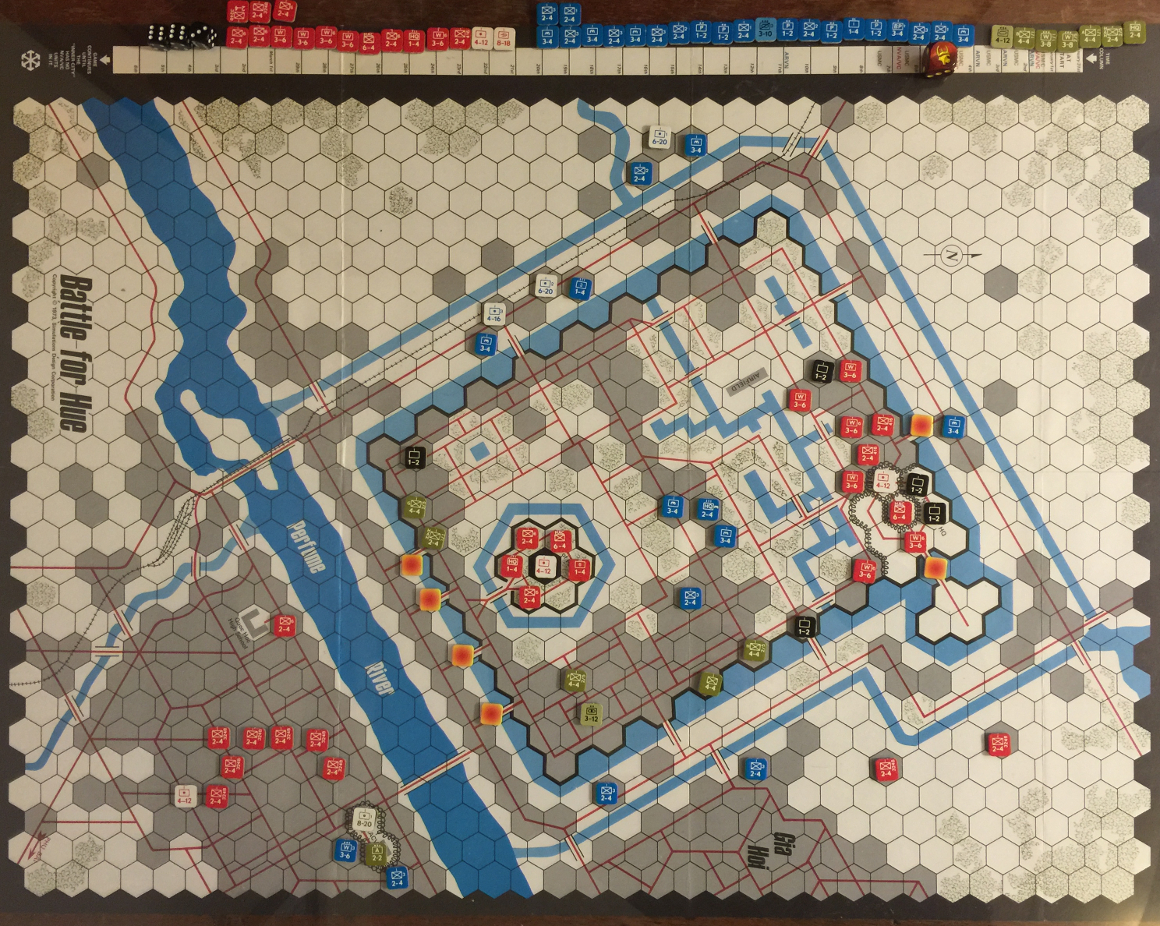
Turn time: 59:44, but I had to install gimp, and I went to refresh my tea while that was happening. I’d say between 30-60 minutes per turn.
Score:
- ARVN/US: 17 units + 12 VC = 29.
- NVA/VC: 7 turns + 22 ARVN + 7x2 USMC = 43.
This is going to be bloody. And long.
February 7, 1968
It’s January 9, 2015. Busy work schedule and personal stuff have limited my time for working through this game for the last couple of weeks. I’m going to try and get a turn or two in today.
Bringing in 3 USMC units 1 turn late.
Roll for VC: 2.
NVA Move Sweeping around from the southeast to either put pressure on ARVN artillery, or getting into inner to block further ARVN entrance.
First Fire Phase Limited fire this turn, but another ARVN eliminated.
ARVN/US Road Move Position to stand outside of NVA range and pick them off one by one. Allied forces have taken too many losses.
ARVN/US Non-road Move Get observation, but don’t close.
Second Fire Phase Allied picked off some commies without any losses. Good day for Allies.
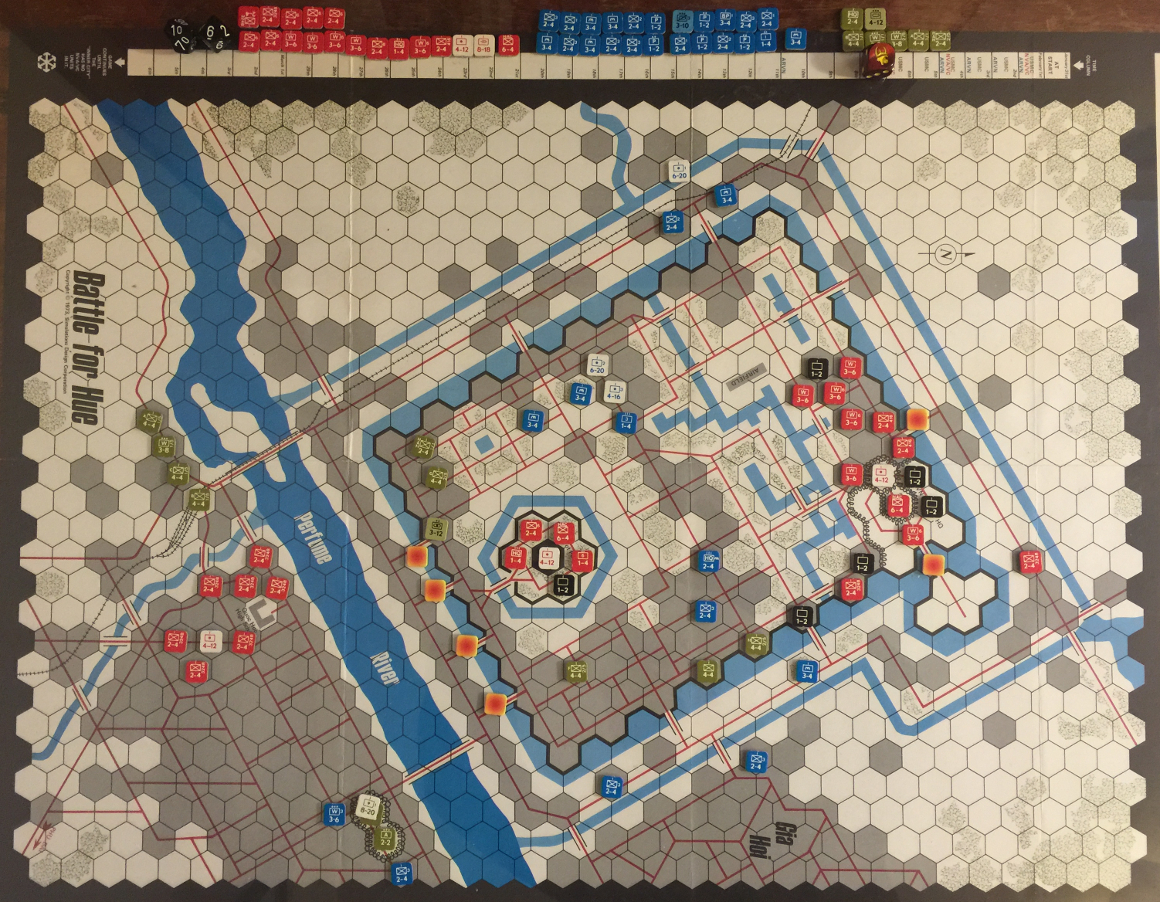
Turn time: didn’t time this turn.
Score
- NVA/VC: 43.
- ARVN/US: 35.
Allied forces are gaining.
February 8, 1968
Roll for VC: 6 (!)
NVA/VC Move Position along south wall with NVA, and move southern NVA artillery up with flanking defensive units for protection.
First Fire Phase Frontal attack on the southern wall by NVA, kills another USMC artillery unit. This is really bad for Marines. Rolling in 11 NVA makes up for the NVA losing some of their artillery earlier in the game. Some no effect fires from VC, but ARVN managed to pick off an NVA weapons company (3-6) on the north side, which is good for ARVN.
ARVN/US Road Move ARVN and USMC need to be really careful and move into positions which are not exposed, and which will be costly for NVA to dig them out of.
ARVN/US Non-road Move Moving ARVN to protect USMC, and to start chewing away at the defense around the southern NVA artillery position. This is cool for ARVN as these defenders are 2-4 infantry companies which cannot call for support during second fire phase.
Second Fire Phase ARVN succeed in killing 2-4 infantry NVA, which puts the NVA arty under pressure now.
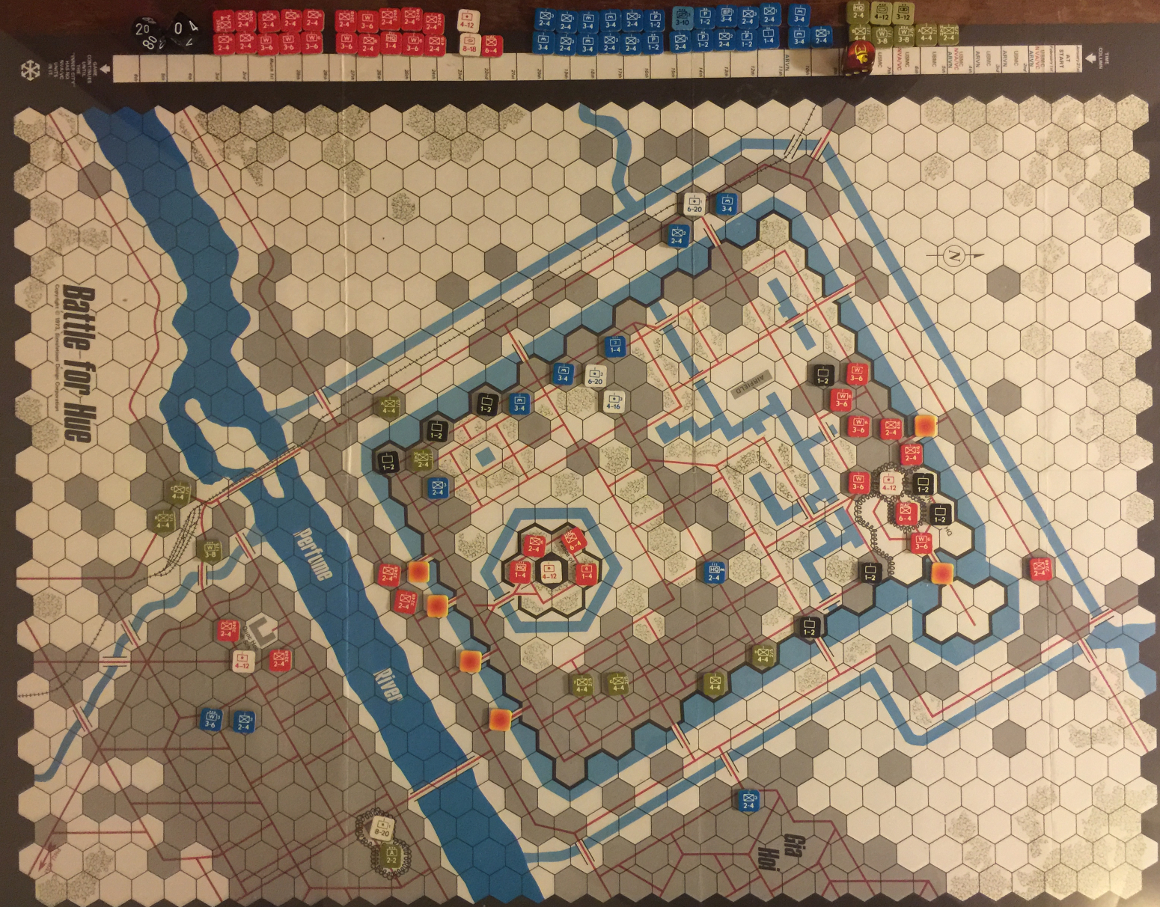
Turn time: 59:32. I’d like to get turn times down around 20 minutes. Seems hard. The photo stuff takes no more than 10 minutes to handle, and usually around 5. Similarly, the writeup doesn’t take that much time either. It’s probably the combination of both which makes it add up. This really is going to be a long slog, but that’s how the Battle for Hue really was.
Score
- NVA/VC: 48.
- ARVN/US: 44.
February 9, 1968
Roll for VC: 2.
NVA/VC Move VC placed in the city blocks on the north side, west of the ARVN 1st HQ. Good for soaking up attacks and running the clock. All commie movement this turn is to avoid firefights.
First Fire Phase No fire.
ARVN/US Road Move Allied forces moving much more cautiously now, focusing on attrition without taking casualties on the south side of the map.
ARVN/US Non-road Move Close on VC to clear roads allowing USMC movement into inner city.
Second Fire Phase Knocked off a few VC.
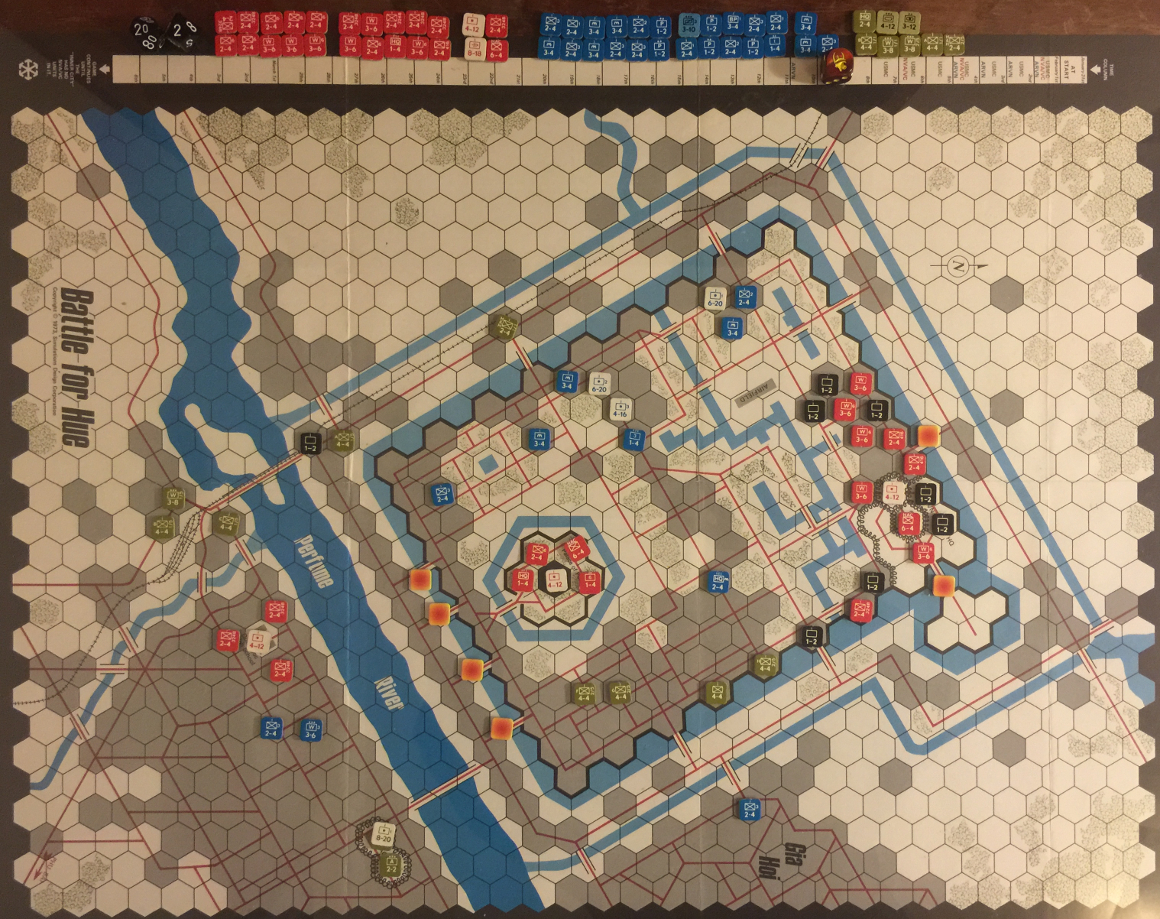
Turn time: 30:23. This turn went fast I think because there was no firefights in the first fire phase, and very few in the second.
Score
- NVA/VC: 49.
- ARVN/US: 47.
Allies really gaining now.
February 10, 1968
Roll for VC: 3.
NVA/VC Move VC move to assault USMC leg company 1/5.
First Fire Phase VC assault fails, more VC lost.
ARVN/US Road Move ARVN artillery move to SE corner of inner city to get half range distance from 1st Div HQ. ARVN reinforcements arrive to keep pressure on NVA artillery in the south.
ARVN/US Non-road Move Close to assault.
Second Fire Phase Taking out NVA and VC at the 12+ column, auto-kills. Takes longer but less risky to concentrate firepower.
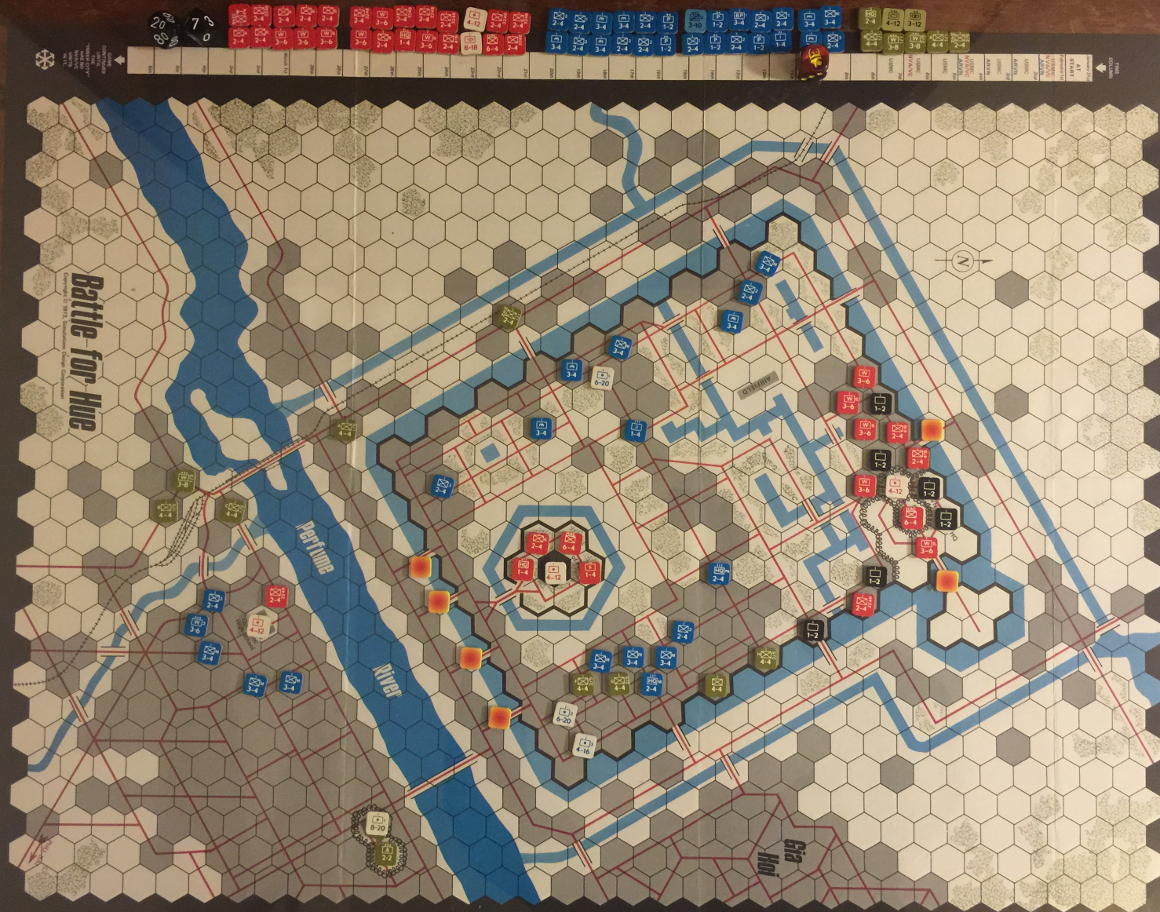
Turn time: 30:49, which is doable.
Should be able to finish out the game over the rest of January easily. I was getting worried I’d get too bored with the length of it and just take it down. But I’m starting to get interested in how the siege on both the 1st ARVN HQ and the Palace of Peace is going to play out. The HQ needs to go first to get rid of the pesky VC rolls every turn.
Score
- NVA/VC: 11 turns + 26 ARVN + 8x2 USMC = 53.
- ARVN/US: 27 VC + 25 NVA + 1x2 HAC = 53.
Tied game. I suspect the Allies will pull ahead for a bit, then fall behind as the seiges get underway.
February 11, 1968
Roll for VC: 4.
NVA/VC Move Not much do to: get the artillery out of the way (or try), and use the VC to wear down ARVN or USMC. Most all NVA need to hold tight at this point.
First Fire Phase Some trading.
ARVN/US Road Move Moving conservatively, taking on small parts of defense instead of trying to engage everything possible. This helps NVA last more turns, but keeps me from getting confused with too much action going down all at once.
ARVN/US Non-road Move None this turn, not necessary.
Second Fire Phase More NVA artillery eliminated, bad luck for NVA, rolled “6” to miss on an +10. Bummer. Actually, would not have mattered as the 2-4 unit would not have been able to call in the indirect fire.
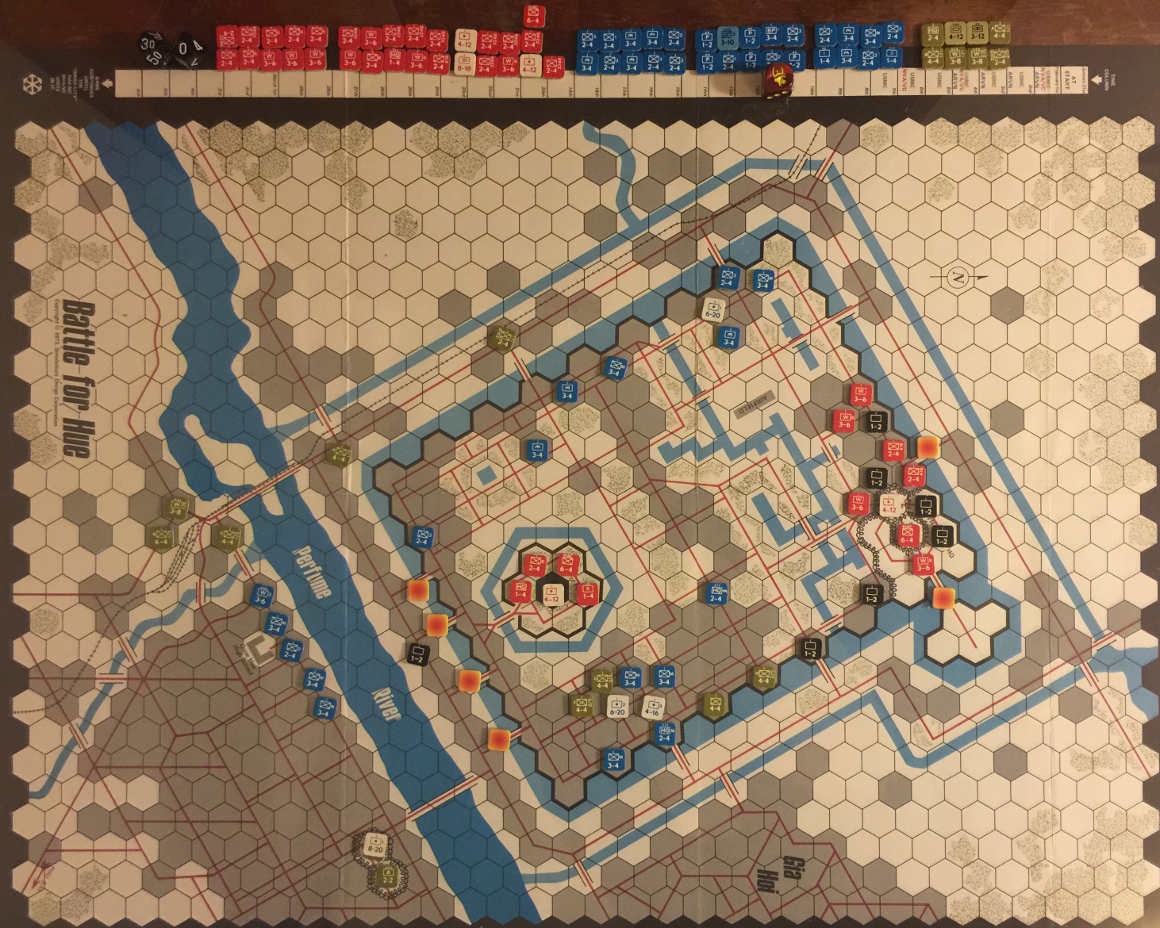
Turn time: 36:36.
Score
- NVA/VC: 12 turns + 28 ARVN + 8x2 USMC = 56.
- ARVN/US: 30 VC + 29 NVA + 1x2 HAC = 61.
February 12, 1968
Roll for VC: 2.
NVA/VC Move which is coming down to where to place incoming VC reinforcements mainly. For now, incoming VC are going to “lay low” until they can build up enough units to do some damage.
First Fire Phase NVA takes a shot at USMC, missed, but return fire eliminates.
ARVN/US Road Move Position to eliminate VC using spotters and arty, bring everything but garrison force at MACV into the inner city.
ARVN/US Non-road Move none.
Second Fire Phase lame, eliminated 1 VC.
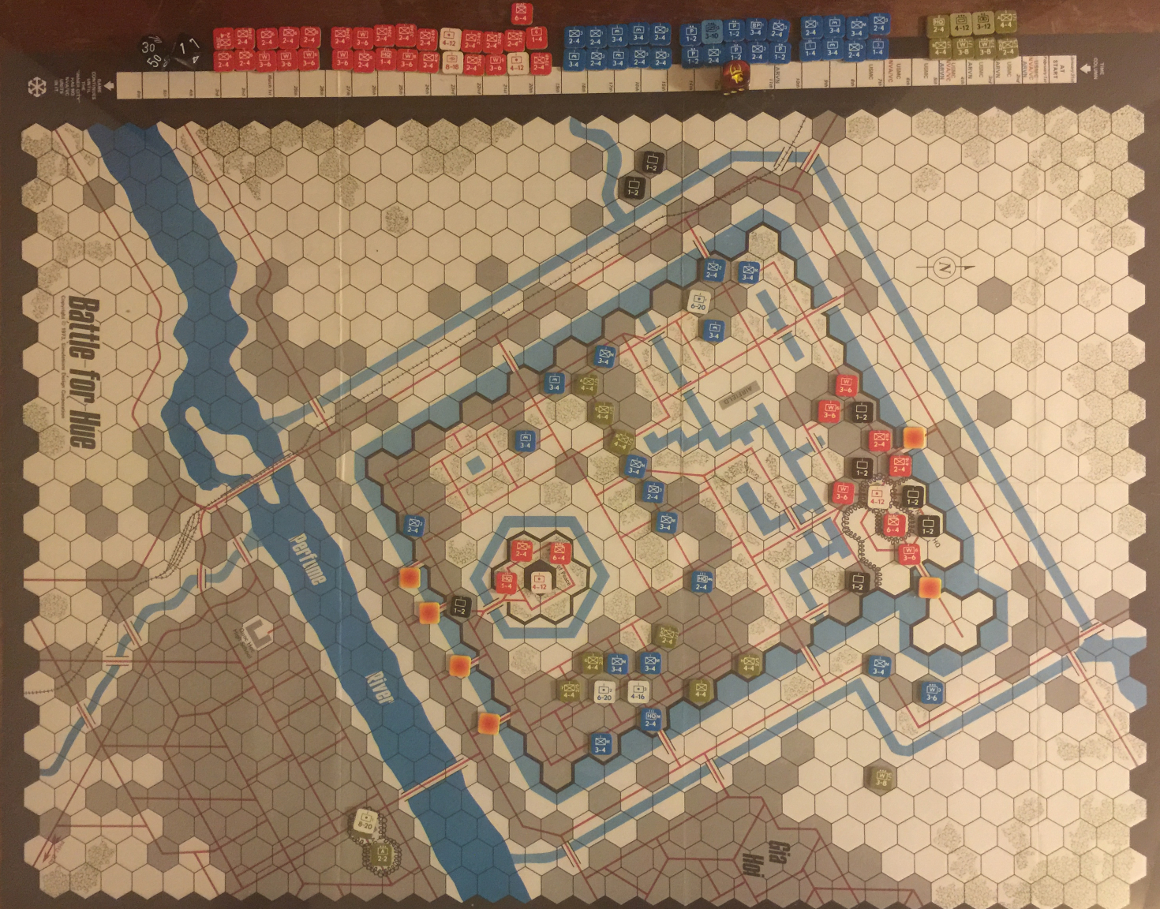
Turn time: did not time this turn.
Score
- NVA/VC: 13 turns + 28 ARVN + 8x2 USMC = 57.
- ARVN/US: 31 VC + 30 NVA + 1x2 HAC = 63.
I don’t see how the NVA can hold out long enough to win it, but we’ll see what happens.
February 13, 1968
Roll for VC: 4.
NVA/VC Move Lacking any idea of what else to do, VC and NVA attempt to take out a USMC unit east of Palace of Peace.
First Fire Phase NVA and VC got lucky, took out USMC 2/5 leg, at no cost, return fire missed.
ARVN/US Road Move Primary move here is swapping out a 4-4 unit for the 3-8 unit in the MACV. That 3-8 is better used where it can stand off and hammer targets from a long ways out. Also, move the ARVN artillery back to get the 10+ range, and the USMC artillery up to get within 20 hex range.
ARVN/US Non-road Move Close in east and north, NVA misses on all first fire after close.
Second Fire Phase Attrition comtinues. ARVN tooks some losses, but it can better afford them. NVA cannot afford to take losses at this point.
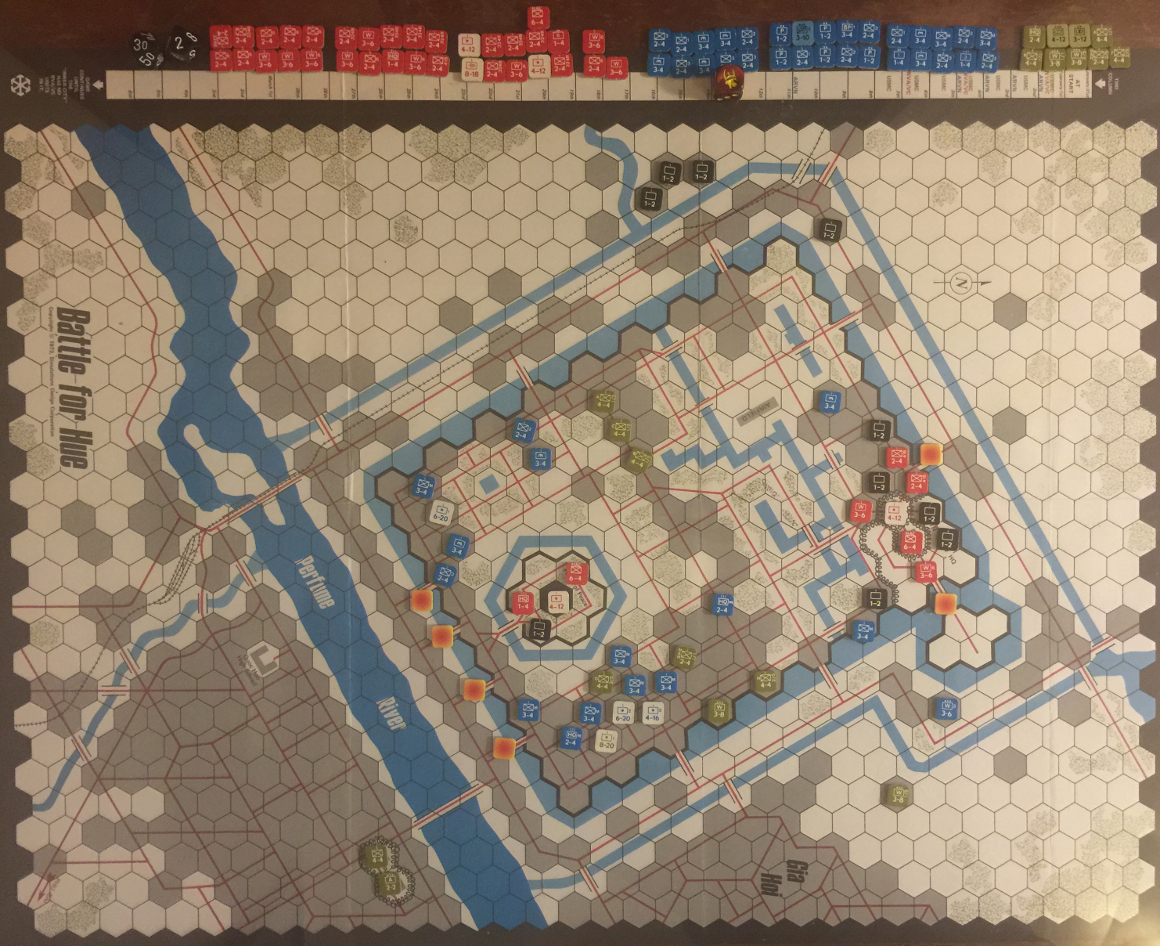
Turn time: 35:48
At this point, I don’t see how the NVA can win it, because they have much fewer forces than the Allies, and staying within the inner city would result in them being ZOC’ed in. But where they’re at right now guarantees a siege, which is also a loss, and possibly sooner than chasing all over the map.
From here out, my interest is how well the siege works, from both attacker and defender points of view. I think this will bring the game to a faster conclusion than having the NVA foxing around the map, however more historically accurate that might be.
Score
- NVA/VC: 30 ARVN + 14 turns + 9x2 USMC = 62.
- ARVN/US: 32 VC + 33 NVA + 1x2 HAC = 67.
February 14, 1968
No writeup for this turn, want to finish out the game now.
Roll for VC: 6.
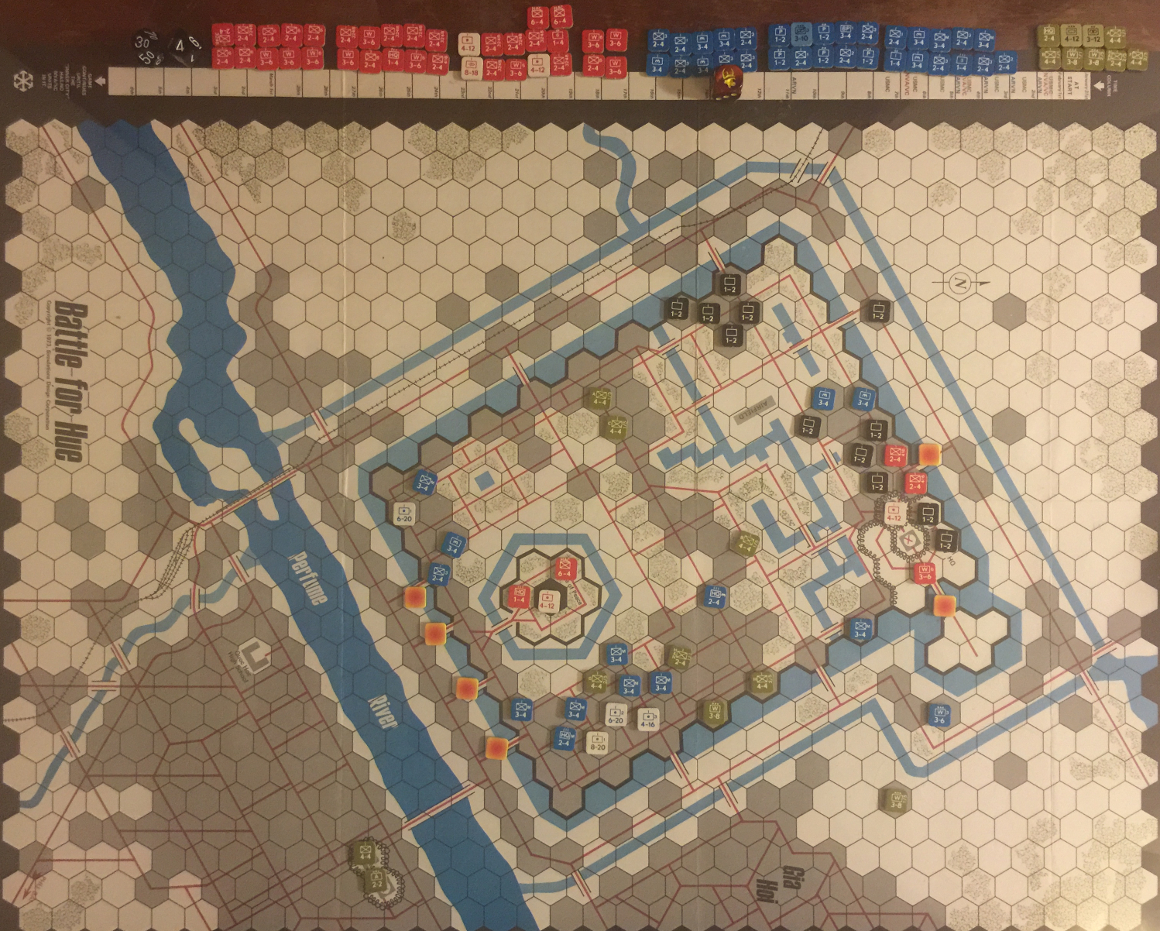
The 1st Div armory fell from NVA hands. They need to reoccupy for a full turn to rearm VC. Not going to happen.
Turn timer: 27:53. Doesn’t look like I saved that much time, might as well continue writing everything up as I go.
Score
- NVA: 15 turns + 31 ARVN + 9x2 USMC = 64.
- ARVN/US: 34 VC + 34 NVA + 2x2 HAC = 72.
February 15, 1968
Turn played on January 15, 2015.
It looks like game pretty much over for NVA, but I’m going to play it out anyway.
No rolling for VC this turn.
NVA/VC Move VC only move to attempt to repel ARVN from northern city.
First Fire Phase Some trading, bad for commies, another loss on the armory bunker.
ARVN/US Road Move Positioning for a big push for driving out NVA from both Palace of Peace and 1st Div HQ.
ARVN/US Non-road Move Closing to assault on Palace of Peace and armory. NVA got really lucky rolling a 1 to remove a 4-4 USMC with 1-4 unit, then rolled a 1 to remove an ARVN from a built-up city hex with a 2-4 unit.
Second Fire Phase NVA kicked major ass this turn.
Turn time: Did not time this turn.
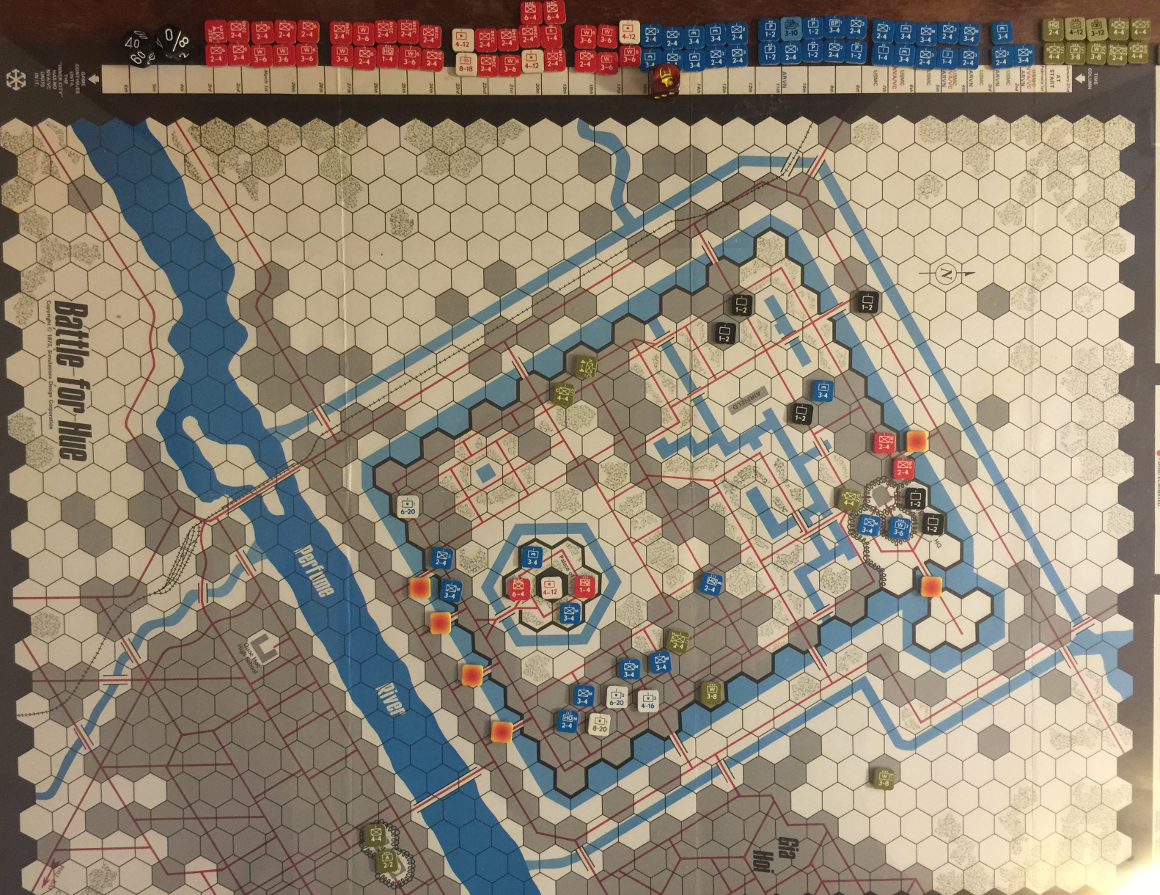
Score
- NVA/VC: 33 ARVN + 11x2 USMC + 16 turns = 71.
- ARVN/US: 40 VC + 36 NVA + 2x2 HAC = 80.
NVA isn’t done yet! I can see how the game could be dragged out at least a few more turns, but I’m kind of bored with it at this point.
Also, I still haven’t used the naval gunfire.
February 16, 1968
NVA/VC Move Some rearranging at the north end, putting a VC on the 1st Div HQ bunker. It survives 3 first fire attacks, which is pretty cool as it likely adds a turn to the game. No movement in Palace of Peace.
First Fire Phase The NVA and VC have a chance to get really lucky here, or unlucky, we’ll see how the die rolls. They got semi-lucky, the HAC unit survived and took an ARVN unit.
ARVN/US Road Move position for “final assault.”
ARVN/US Non-road Move Hopefully the final assault. One first fire NVA 2-4 misses.
Second Fire Phase HAC unit is out. NVA at north end reduced to a single unit.
Turn time: did not time this turn.
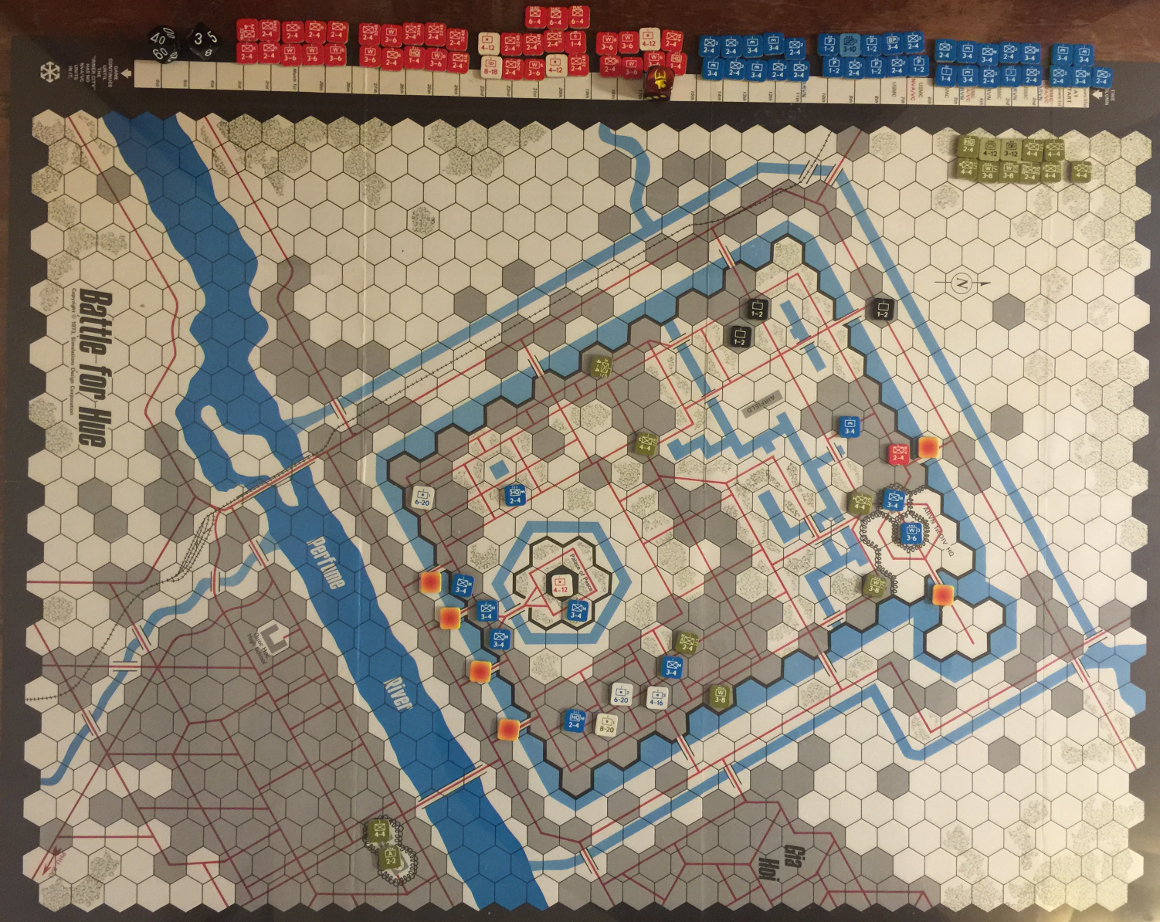
Score
- NVA/VC: 35 ARVN + 11x2 USMC + 17 turns = 74.
- ARVN/US: 38 NVA + 43 VC + 3x2 HAC = 87.
Just for fun, I rolled a “3” on an attack at force 12 around Palace of Peace, which would have eliminated final NVA unit in that area.
The final scores would have been something like 115-85 if it was played all the way out such that the ARVN/US got the 20 point bonus for clearning the inner city.
AAR
TODO: Post a note on the Vietnam BGG list for the Battle of Hue entry.
As usual for a first game, a lot of what I did was push counters around to see what would happen. Between that and the blunders listed below, there is surely vast opportunity for improving game play.
Strategy
- NVA need to protect artillery.
Blunders
- Clearly, the initial ARVN blunder was not packing in all available ARVN units around the armory and 1st Div. HQ.
- Another ARVN/US blunder: not bringing reinforcements on Feb. 1 on schedule. These units could have possibly taken out NVA artillery.
- Forgot about NVA artillery in the Palace of Peace on the first 2 turns.
- NVA blundered by not dropping as many bridges as possible using every unit not tied up attacking the ARVN armory. Granted, blowing bridges is an optional rule, and one would hope it’s possible to win as NVA/VC without blowing bridges, but it just seems to make good sense.
- ARVN 1st Div should have tried to blow the armory, although, the NVA moved so fast and got so lucky they may not have been able to move away in time.
- NVA made huge blunder by putting artillery in wall corner hexes, then not moving them away, hence losing them to ARVN on turn 3.
- Forgot to roll for VC activation as a result of capturing the ARVN 1st Div. HQ. I believe I missed only one turn though.
- Did not airlift ARVN on Feb. 3, despite having a clear airfield. Conversely, did not block the arifield with VC or NVA to prevent airlift.
- DRMs accumulate, and I’ve been Doing It Wrong for defensive positions in behind walls in city hexes. For some reason I believed that was a +3 DRM, but it’s really +4, as the wall is +2 and the city hex is +2. This changes things quite a bit, as the odds shift towards the NVA/VC defender from 5/6 to eliminate to 4/6. I can see why this game takes so many turns: it’s really tough to root out defenders.
- Remember that NVA 2-4 infantry can only spot on first fire phase, while NVA 3-6 weapons can spot on both fire phases. This makes a difference in play, and I’m sure that there were several Allied units knocked out because of using NVA 2-4 spotting.
- Not bringing in naval gunfire on Turn 12.
- Torwards the end game, the VC could have made more blocking moves to slow down ARVN retaking the 1st Div HQ. It wouldn’t have changed the outcome much, maybe swung it 10-15 points in favor of communists, which would not have been enough.
- Not surrounding Palace of Peace with loads of units. The odds decrease with units firing from outside the walls, but the problem with getting inside the walls is losing units to first fire on ZOC entry, which is what happened on Feb. 15 turn.
- Put a HAC unit in the Palace of Peace proper, and sell that thing dearly. This could have increased NVA/VC score by a few points.
Handicapping
Another cool thing about Battle for Hue is it admits two types of handicapping immediately. The first is simply specifying the number of VC coming in on February 1. The second is ???
Footnotes
-
This was originally mis-computed as 12+ using the full strength of artillery against bunkers. The error was caught in Turn 2, and it turns out changing the first die roll from “4” to “3” leaves all results unchanged, so I decided to let it stand. Also, as noted in the “Blunders,” the artillery in the Palace of Peace wasn’t used, and would have given just enough to tip the firepower to the 12+ column. ↩